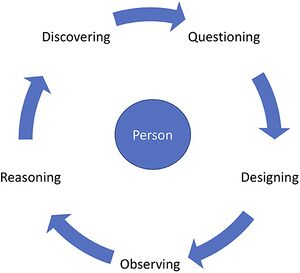Getting started with personal science
- This page is about how to get started with your own personal science project. See Getting started with wiki syntax for details on how to use this wiki.
Getting started with personal science can feel intimidating as there are a lot of components to consider when trying to answer personal questions. This page tries to accumulate best practices and advice to help both newcomers and experienced personal scientists in thinking and designing their personal science efforts. It is based on years of experience of personal scientists and is a living guide, which means that you are invited to edit and improve this article as well.
A framework for Personal Science
In 2020, Gary Wolf and Martijn De Groot published an article presenting a conceptual framework for personal science[1], which consists of five stages: "Questioning", "Designing", "Observing", "Reasoning" and "Discovering". Since then, this framework has been simplified in some places. Both the book "Personal Science" as well as the Quantified Self "Get Started" guide[2] have removed the "Designing" stage from their advice.
This simplification was done as it can be very hard to differentiate between "design" and "observation" as they often relate to each other and changes in the project design are often related to initial observations.
Questioning
The step of questioning requires thinking about why one wants to do a self-research project in the first place. It is also one of the most important steps in deciding to do a project, as it will inform all other decisions (e.g. on which methods or tools to use, which things to track etc.). There can be many reasons to start a self-research projects. Some common reasons that have motivated people in the past include,
- Increasing self-awareness (e.g. when/where is particular thing happening to me)
- Learning about the frequency or intensity of things (e.g. of symptoms like pain or allergies or changes in mood, weight or other phenomena)
- Improving ones health or well-being, e.g. when having a chronic condition
- Making progress in physical training or sports, trying to recover from an injury
- Creatively expressing oneself through data and visualizations
- Wanting to learn a new skill
Framing a question
A good starting point for a personal science project can be to just write down a small bit on the goals and questions one is trying to answer with this. There is no "right" way for where or how to write this. One can write a few sentences in a physical notebook, somewhere in a digital notes tool or even create a small project page in this wiki (it can be as little as in this example). One doesn't have to share this brainstorming step with others, but by making it publicly available and discussing it with others one gets the opportunity to get feedback and advice early on.
In the context of health-related questions, it might also be better to start from exploring ones own experiences rather than trying to dive into trying to find causes right from the start. Collecting data to conclusively "proof" a certain diagnosis is a very high bar to take and can be an overwhelming task to start out in a personal science project. Instead, it might be worth focusing on questions like "How bad are my symptoms?", "How often do they occur?", "What helps to improve my condition?". Framing questions this way might make it easier to make observations and reason about the records one collects.
References
- ↑ Wolf GI and De Groot M (2020) A Conceptual Framework for Personal Science. Front. Comput. Sci. 2:21. doi: 10.3389/fcomp.2020.00021
- ↑ https://quantifiedself.com/get-started/
